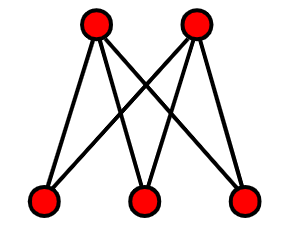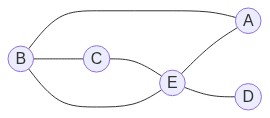8.2 KiB
8.2 KiB
- #MA284 - Discrete Mathematics
- Previous Topic: Introduction to Graph Theory
- Next Topic: Convex Polyhedra
- Relevant Slides:
-
Definitions
- What is a walk? #card
card-last-interval:: 2.8
card-repeats:: 2
card-ease-factor:: 2.6
card-next-schedule:: 2022-11-26T07:16:18.888Z
card-last-reviewed:: 2022-11-23T12:16:18.890Z
card-last-score:: 5
- A walk is a sequence of vertices such that consecutive vertices are adjacent.
- What is a trail? #card
card-last-interval:: -1
card-repeats:: 1
card-ease-factor:: 2.5
card-next-schedule:: 2022-11-15T00:00:00.000Z
card-last-reviewed:: 2022-11-14T16:14:59.935Z
card-last-score:: 1
- A trail is a walk in which no edge is repeated.
- What is a path? #card
card-last-interval:: 0.9
card-repeats:: 2
card-ease-factor:: 2.36
card-next-schedule:: 2022-11-15T17:22:40.523Z
card-last-reviewed:: 2022-11-14T20:22:40.524Z
card-last-score:: 3
- A path is a trail in which no vertex is repeated, except possibly the first & last.
- The path on
nvertices is denotedP_n.
-
Example
- What is the length of a path? #card
card-last-interval:: -1
card-repeats:: 1
card-ease-factor:: 2.5
card-next-schedule:: 2022-11-15T00:00:00.000Z
card-last-reviewed:: 2022-11-14T20:22:48.413Z
card-last-score:: 1
- The length of a path is the number of edges in the sequence.
-
Cycles & Circuits
- What is a cycle? #card
card-last-interval:: -1
card-repeats:: 1
card-ease-factor:: 2.5
card-next-schedule:: 2022-11-15T00:00:00.000Z
card-last-reviewed:: 2022-11-14T15:50:16.908Z
card-last-score:: 1
- A cycle is a path that begins & ends at the same vertex, but no other vertex is repeated.
- A cycle on
nvertices is denotedC_n.
- What is a circuit? #card
card-last-interval:: -1
card-repeats:: 1
card-ease-factor:: 2.5
card-next-schedule:: 2022-11-22T00:00:00.000Z
card-last-reviewed:: 2022-11-21T13:05:28.290Z
card-last-score:: 1
- A circuit is a path that begins & ends at the same vertex, and no edge is repeated.
- What is a cycle? #card
card-last-interval:: -1
card-repeats:: 1
card-ease-factor:: 2.5
card-next-schedule:: 2022-11-15T00:00:00.000Z
card-last-reviewed:: 2022-11-14T15:50:16.908Z
card-last-score:: 1
- What does it mean if a graph is connected? #card
card-last-interval:: 2.8
card-repeats:: 1
card-ease-factor:: 2.6
card-next-schedule:: 2022-11-17T11:16:09.571Z
card-last-reviewed:: 2022-11-14T16:16:09.572Z
card-last-score:: 5
- A graph is connected if there is a path between every pair of vertices.
- What is the degree of a vertex? #card
card-last-interval:: 4
card-repeats:: 2
card-ease-factor:: 2.7
card-next-schedule:: 2022-11-25T13:10:12.122Z
card-last-reviewed:: 2022-11-21T13:10:12.123Z
card-last-score:: 5
- The degree of a vertex is the number of edges emanating from it.
- If
vis a vertex, we denote its degree asd(v).
-
Handshaking Lemma
- If we know the degree of every vertex in the graph, then we know the number of edges. This is the Handshaking Lemma.
- What is the Handshaking Lemma? #card
card-last-interval:: -1
card-repeats:: 1
card-ease-factor:: 2.5
card-next-schedule:: 2022-11-15T00:00:00.000Z
card-last-reviewed:: 2022-11-14T15:54:11.744Z
card-last-score:: 1
- In any graph, the sum of the degrees of vertices in the graph, is always twice the number of edges.
-
\sum_{v \in V} d(v) = 2|E|
-
- In any graph, the sum of the degrees of vertices in the graph, is always twice the number of edges.
- What is a walk? #card
card-last-interval:: 2.8
card-repeats:: 2
card-ease-factor:: 2.6
card-next-schedule:: 2022-11-26T07:16:18.888Z
card-last-reviewed:: 2022-11-23T12:16:18.890Z
card-last-score:: 5
-
Types of Graphs
- What is a Complete Graph? #card
card-last-interval:: 0.9
card-repeats:: 2
card-ease-factor:: 2.36
card-next-schedule:: 2022-11-15T17:23:00.989Z
card-last-reviewed:: 2022-11-14T20:23:00.990Z
card-last-score:: 3
- A graph is complete if every pair of vertices is adjacent.
- This family of graphs is very important.
- Complete graphs are denoted
K_n- the complete graph onnvertices.
- A graph is complete if every pair of vertices is adjacent.
- What is a Bipartite Graph? #card
card-last-interval:: 8.35
card-repeats:: 3
card-ease-factor:: 2.46
card-next-schedule:: 2022-11-29T21:09:36.899Z
card-last-reviewed:: 2022-11-21T13:09:36.899Z
card-last-score:: 5
- A graph is bipartite if it is possible to partition the vertex set,
V, into two disjoint sets,V_1&V_2, such that there are no edges between any two vertices in the same set.
- A graph is bipartite if it is possible to partition the vertex set,
- What is a Complete Bipartite graph? #card
card-last-interval:: -1
card-repeats:: 1
card-ease-factor:: 2.5
card-next-schedule:: 2022-11-15T00:00:00.000Z
card-last-reviewed:: 2022-11-14T15:51:45.394Z
card-last-score:: 1
- If a bipartite graph is such that every vertex in
V_1is connected to every vertex inV_2(and vice versa), the graph is a complete bipartite graph. - If
|V_1| = mand|V_2| = n, we denote itK_{m,n}.
- If a bipartite graph is such that every vertex in
- What is a subgraph? #card
card-last-interval:: 3.05
card-repeats:: 2
card-ease-factor:: 2.6
card-next-schedule:: 2022-11-17T21:23:07.436Z
card-last-reviewed:: 2022-11-14T20:23:07.436Z
card-last-score:: 5
- We say that
G_1 = (V_1, E_1)is a subgraph ofG_2 = (V_2, E_2)providedV_1 \subset V_2andE_1 \subset E_2.
- We say that
- What is an induced subgraph? #card
card-last-interval:: -1
card-repeats:: 1
card-ease-factor:: 2.5
card-next-schedule:: 2022-11-23T00:00:00.000Z
card-last-reviewed:: 2022-11-22T13:38:04.242Z
card-last-score:: 1
- We say that
G_1(V_1, E_1)is an induced subgraph ofG_2 = (V_2, E_2)provided thatV_1 \subset V_2andE_2contains all edges ofE_1which join edges inV_1.
- We say that
- What is a Complete Graph? #card
card-last-interval:: 0.9
card-repeats:: 2
card-ease-factor:: 2.36
card-next-schedule:: 2022-11-15T17:23:00.989Z
card-last-reviewed:: 2022-11-14T20:23:00.990Z
card-last-score:: 3
-
Planar Graphs
- What is a planar graph? #card
card-last-interval:: -1
card-repeats:: 1
card-ease-factor:: 2.5
card-next-schedule:: 2022-11-15T00:00:00.000Z
card-last-reviewed:: 2022-11-14T16:19:45.615Z
card-last-score:: 1
- If you can sketch a graph such that none of its edges cross, it is a planar graph.
- What is a face? #card
card-last-interval:: 0.98
card-repeats:: 1
card-ease-factor:: 2.36
card-next-schedule:: 2022-11-15T15:22:52.013Z
card-last-reviewed:: 2022-11-14T16:22:52.013Z
card-last-score:: 3
- When a planar graph is drawn without edges crossing, the edges & vertices of the graph divide the plane into regions called faces.
- The number of faces does not change no matter how you draw the graph, as long as no edges cross.
-
Example
- The graph
K_{2,3}is planar. background-color:: red
- draws/2022-10-28-11-04-05.excalidraw
- The planar representation
K_{2,3}has 3 faces (the "outside" region counts as a face).
- Give a planar representation of
K_4, and count how many faces it has. background-color:: red - Why "face"? background-color:: red
- The graph
- What is a planar graph? #card
card-last-interval:: -1
card-repeats:: 1
card-ease-factor:: 2.5
card-next-schedule:: 2022-11-15T00:00:00.000Z
card-last-reviewed:: 2022-11-14T16:19:45.615Z
card-last-score:: 1
-
Euler's Formula for Planar Graphs #card
card-last-interval:: -1 card-repeats:: 1 card-ease-factor:: 2.5 card-next-schedule:: 2022-11-15T00:00:00.000Z card-last-reviewed:: 2022-11-14T16:18:07.821Z card-last-score:: 1- For any ^^(connected) planar graph^^ with
vvertices,eedges, andffaces, we have:-
v - e + f = 2
-
-
Outline of Proof
- Start with
P_2.- Here,
v=2,e = 1,f=1. Sov-e+f=2. - Any other graph can be made by adding vertices & edges (or just edges) to
P_2.
- Here,
- Suppose
v-e+f=2for a graph.- If we add a new edge with a new vertex, then no new face is created, so
v-e+fdoes not change. - If we add a new edge without a new vertex, then
fwill increase by 1, so again,v-e+fdoes not change.
- If we add a new edge with a new vertex, then no new face is created, so
- Start with
-
Example
- Is it possible for a connected planar graph to have 5 vertices, 7 edges, and 3 faces? Explain.
background-color:: red
- No. Euler's formula tells us that
v-e+f=2.- Here,
v=5,e=7,f=3, sov-e+f=1.
- Here,
- Any such graph is not planar.
- No. Euler's formula tells us that
- Is it possible for a connected planar graph to have 5 vertices, 7 edges, and 3 faces? Explain.
background-color:: red
- For any ^^(connected) planar graph^^ with

